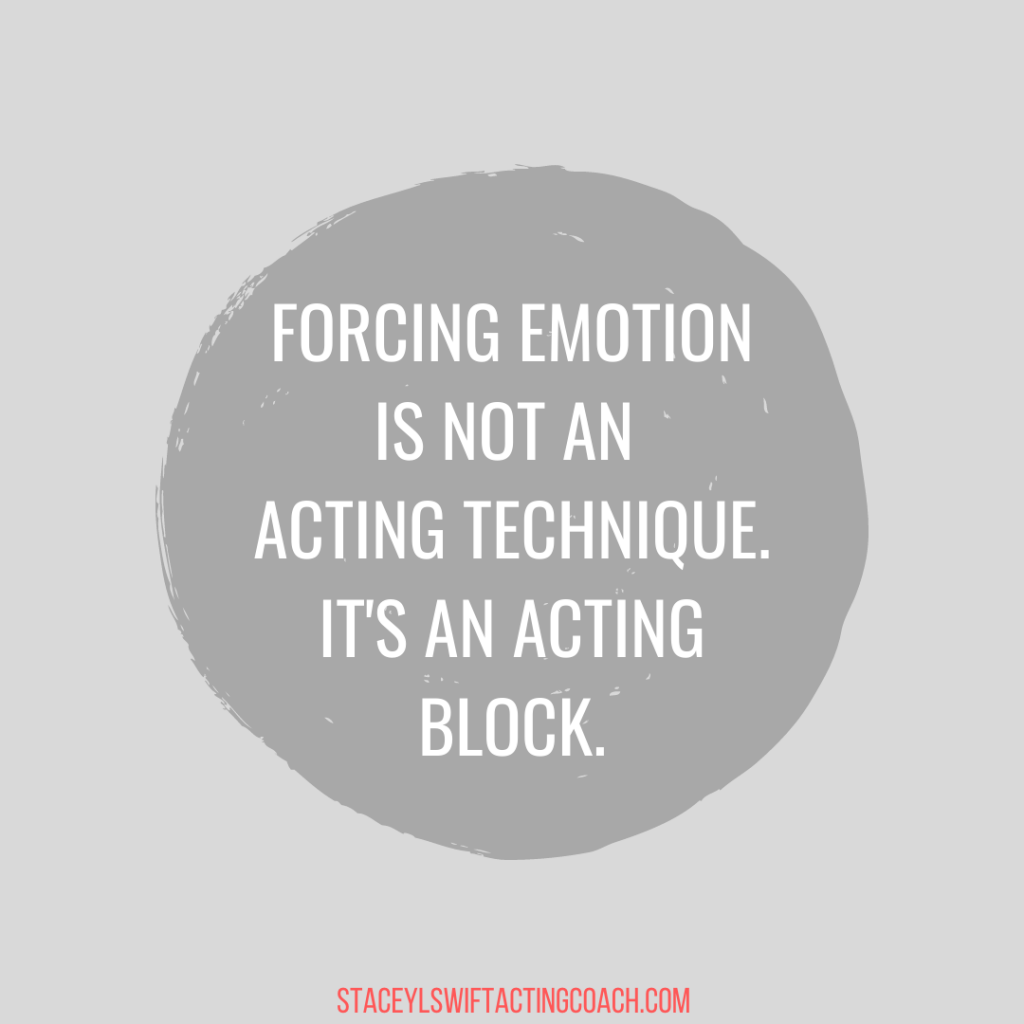Forcing emotion is not an acting technique. It’s an acting block.
Forcing emotion leads to over-acting. Commonly referred to as ‘pushing’ or ‘manufacturing emotion.’ It’s hard to watch. It feels contrived. This habit removes you from the moment and cuts off all possibilities of connecting with the scene. Connecting with the character or other characters or the circumstances… and the list goes on.
The result: the audience doesn’t care, is not moved, feels nothing. Not exactly the result you’re looking for, right?
So why shouldn’t an actor focus on emotions?
In reality, humans never focus on feelings. We’re too busy trying to get away from our feelings. We don’t want to feel complex emotions like loss, grief, insecurity, fear, anger – so we busy ourselves with distractions and activities. We employ the ego and self-defence mechanisms to save face. Maintain composure. Keep up the appearance of being in control. If you trip in the street, lose your footing, and start falling over – your reflexes kick in and try to find your balance. You want to stop the fall. You don’t want to keep falling. We don’t want to wallow in our feelings either. Only actors do that.
Humans seek to express, fix, deny, hide, bury and change our feelings. Notice those are all of those words are active verbs.
But don’t I have to feel what the character feels?
Yes. Understanding, identifying, and connecting to what a character feels is the job. And there are plenty of ways to explore emotional states which will get you where you need to go. That’s another blog.
The problem lies in the pursuit of emotion at the expense of all else. Either the actor fully inhabits an emotion, but is so inward-focused, they’re acting in a bubble – excluding the world around them and everyone in it, or they are forcing an artificial emotion which achieves the same result. Only worse, because it’s not believable. It’s acting without acting objectives. It’s acting in a vacuum. Alone. Or in the mirror.
Let’s look at an example:
You are playing the mother of a child that is dying. She has days to live. The daughter is weak and in a hospital bed. That’s the extent of the given circumstances given to the actors. The acting teacher directs the actor playing the mother to enter the room and Improv a scene with her dying daughter. That’s the brief.
The actor playing the mother decides she must be overcome with emotion and tries to bring herself to tears off to the side. She enters the room. She leans against the wall and begins to sob. Maybe she organically connects to the imagined pain or maybe just pushes and forces emotion.
What’s happening – she’s working primarily with emotion, or the presentation of emotion. She’s decided what the scene is going to look like and works in isolation. She is not present or connecting to her scene partner. After all, there is another person in the scene.
The acting teacher directs the mother to use the objective:
- I want to ease my daughter’s pain.
There’s an instant shift. The actor playing the mother walks over to her daughter and adjusts her blanket. She combs her hair gently. She begins to sing to her. The actor playing the daughter squeezes her mother’s hand. She wakes a bit responding to her mother’s touch, she smiles. A connection is made.
That scene, vs. the first, has the potential to organically evolve because now the actors are working off each other. We are drawn in. Acting objectives in line with the given circumstances and emotional states are more likely to get the actor emotionally available and connected to the scene. And we, the audience, will feel that connection.
Are you guilty of pushing and forcing emotion?
Don’t fret, it’s a common actor habit and one that can be re-trained with time and attention. And while this is a basic overview of the problem, you can start shifting your focus right away. If you work from a place of pursuing actionable acting objectives and tactics, you stand a good chance of producing inspired, connected, and honest acting that is a joy to watch. Which is exactly the result actors are trying to achieve. And it’s a joy to watch.

